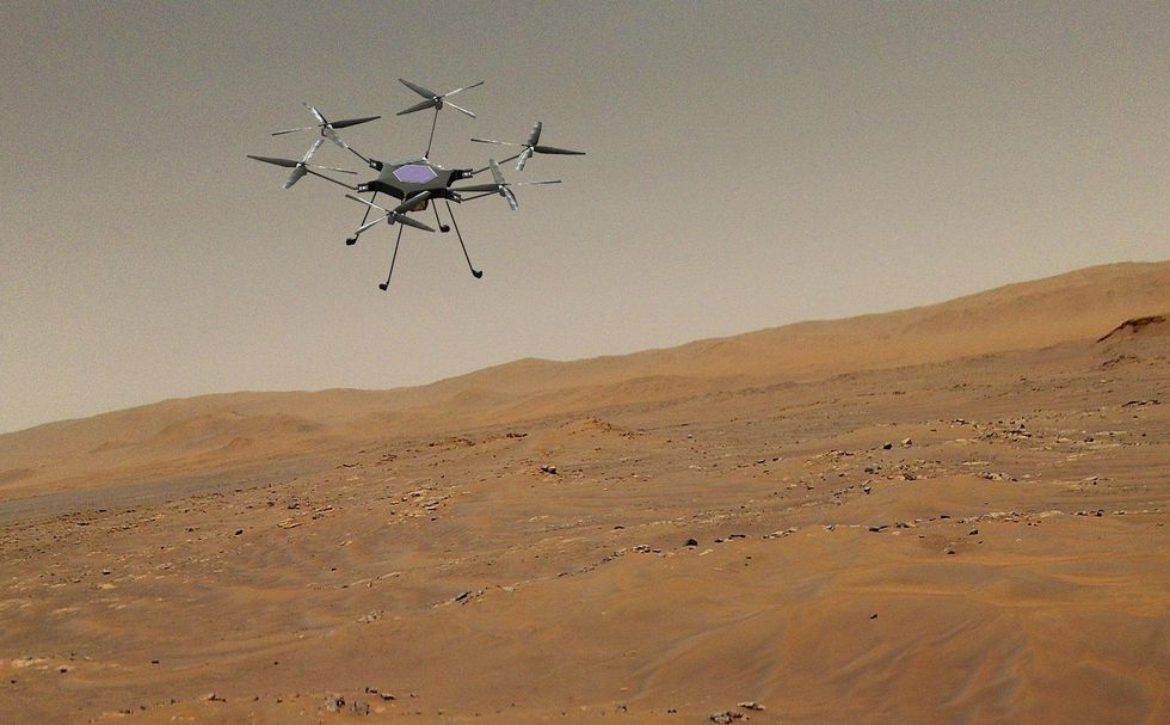
JPL’s Plan For The Next Mars Helicopter
The Ingenuity Mars Helicopter is currently preparing for its 12th flight in Jezero Crater on Mars, which is 11 flights more than was strictly necessary for NASA to have declared the technology demonstrator a success. Over the last four months, Ingenuity has proven that flight on Mars is not only possible, but practical, and can contribute tangible scientific value—even for a vehicle that was not designed to do much in the way of science at all.
The question now is how Ingenuity’s spectacular performance will influence NASA’s future Mars exploration strategy.
It turns out NASA has been thinking about this since long before Ingenuity landed on Mars. About three years ago, as Ingenuity’s design and testing phase was mostly over and the Perseverance rover was getting closer to launch, roboticists at the Jet Propulsion Laboratory (JPL), NASA Ames Research Center, and
AeroVironment (a company that helped to develop Ingenuity) got together and began to sketch out what a next generation Mars helicopter might look like. How would a Martian helicopter effectively scale up? What kinds of science instruments could it carry? What missions could only be done with such a helicopter?
The result was the
Mars Science Helicopter (MSH), a 30-kilogram hexacopter able to do unique science on the Martian surface without requiring rover support.
The first element in JPL’s design approach was to provide as many options as possible to the scientific community, explains
J. (Bob) Balaram, Ingenuity Chief Engineer at JPL and one of the authors of a white paper on the Mars Science Helicopter. That meant thinking about all kinds of different vehicle sizes and mission architectures. “Ingenuity could be scaled both up and down,” Balaram tells us. “We could make it even smaller, into a scout. Or, we could scale it up into a full-size standalone helicopter. And there are things in between, maybe something in the 5kg class, where it’s taking samples from distant sites and bringing them back to a lander for analysis.” JPL presented this menu of Mars helicopter options to planetary scientists, asking them to imagine what kinds of new research might be possible with each platform. And there’s a lot to imagine.
Airborne Science on Mars
“This is a brand new way of looking at Mars,” Balaram says. “Aerial mobility gives you reach, range, and resolution. You can reach places that no wheeled vehicle can get to. You can travel kilometers every day. And depending on what height you fly at, you can get whatever resolution you want with your instruments. We were just telling the scientists, think big!”
Here are examples of some of the ways in which scientists have been thinking big, in the form of two potential missions for a future Mars Science Helicopter.
Mawrth Vallis: Searching for Life at Inaccessible Sites
A version of MSH could image and sample crater walls, inaccessible to ground robots.
Mawrth Vallis is a huge 640-kilometer long outflow channel that may have hosted rivers, lakes, and wetlands about 3.5 billion years ago. On Earth, minerals found at sites like these preserve organic material. This mission concept would combine a stationary lander with smaller helicopter using a two rotor coaxial design, similar to Ingenuity. The helicopter would scout for promising locations over a wide area, and then use an arm and microdrill to bring samples back to the lander, which would carry science instruments including a micro-imaging suite and a life-detection instrument. And on the off chance that life is discovered on Mars, airborne sampling from a helicopter would help to guard against contamination.
Milankovič Crater: Mapping Subsurface Water Ice
A hexacopter version of MSH could map subsurface water ice over a large area, while also collecting atmospheric data from the lower atmosphere that’s hard to measure from the surface or from orbit.
High northern latitudes on Mars are thought to host a significant amount of water ice just under the surface. This is important for understanding the water cycle and climate history of Mars, and also because water ice can potentially provide oxygen to breathe as well as rocket fuel for future human exploration. Creating accurate maps of subsurface ice from orbit is challenging, but a large hexacopter version of MSH equipped with a neutron spectrometer, infrared imager, and meteorology package would be able to provide high resolution data over a very large area.
“You’d shoot a little projectile from the drone that embeds itself in the cliff wall, and then you’d reel it back in with a sample.”
Within these mission scenarios, perhaps the most astonishing potential application suggested in the white paper is contact interrogations of otherwise inaccessible surfaces—that is, taking in-flight samples of rocks or soil from areas that a rover (and perhaps even a human) could never reach, like midway up a cliff wall. “The ability to do station keeping against a cliff wall is fairly standard machine vision,” Balaram says. “So then the question becomes, what is the actual end effector? You can imagine something like a penetrator with a reel-in device. You’d shoot a little projectile from the drone that embeds itself in the cliff wall, and then you’d reel it back in with a sample. Or maybe you find some green slime that you want to collect, so you shoot something at it that’s sticky, like fly paper. This is the kind of science that we can potentially do.”
A Serious Engineering Effort
Each of the Mars Science Helicopter’s rotors is the size of Ingenuity’s rotors. Balaram describes MSH as “basically six Ingenuitys.”
Although MSH’s science payload is still very conceptual, Balaram says that the concept for the vehicle itself “isn’t just a cartoon—it’s a serious engineering effort.” The hexacopter shown in the rendering above is the most mature design; JPL considered simply scaling up Ingenuity and making MSH a larger coaxial helicopter, but Balaram explains that there were some control issues that, while not unsolvable, make a hexarotor design more appealing. The hexacopter airframe will be somewhat heavier than the coaxial design, but a hexacopter also has the advantage of being able to operate with one (or even possibly two) nonfunctional rotors.
The current MSH concept has a mass of about 31 kg and a total diameter of just over four meters, with six rotors each sporting a quartet of 0.64 meter blades. The payload of 5 kg gives MSH what Balaram calls a very attractive sweet spot for science instruments. MSH would have a top speed of about 30 m/s, a five minute hover time, or a range of up to 10km per flight, and a solar cell on top of the vehicle would be able to recharge MSH’s batteries over the course of one Martian day. This kind of range and speed means that MSH could cover as much ground in a few days as a rover like Curiosity has covered in years. JPL and its partners have also been working on things like blade design, manufacturability, and how MSH would fold up inside of an aeroshell for entry, descent, and landing. There’s even the exciting possibility of a mid-air deployment as part of the landing process, which would avoid the additional cost and complexity of a dedicated lander.
MSH could fold up to fit inside of the same aeroshell used for the Mars Pathfinder mission.
Since much of the work done on the Mars Science Helicopter took place before Perseverance and Ingenuity landed on Mars, the MSH team has been learning a lot about Martian rotorcraft operations from how Ingenuity has been performing over the last several months, which in turn is informing design decisions about MSH. “One of the main unknowns that we had was how much we could rely upon orbital images to pick landing sites,” Balaram says. Ingenuity has shown that orbital images are actually pretty good for this, and even with relatively low resolution images, finding safe landing fields is fairly reliable. This means MSH might not need quite as sophisticated of a hazard detection system for making autonomous landings, simplifying the design and saving mass. Ingenuity’s experience has also given the MSH team more confidence about flying in windy conditions. “In terms of the control performance, Ingenuity has turned out to be exceeding our expectations,” says Balaram, which translates into potentially tuning the performance of MSH to be a little less conservative. “It’s kind of like, let’s just relax our design margins, because some of the tough problems that we thought were tough are probably not as challenging as we thought they could be. So those lessons learned feed forward into the science helicopter.”
Ingenuity has also shown how modern computing hardware and software can be used in spacecraft. Its technology demo status meant that JPL could get a little more creative than normal, using a Qualcomm Snapdragon 801 running Linux which gave the little helicopter 150 times more computing power than the Perseverance rover. Balaram wants to leverage Ingenuity’s success into a similar approach with MSH: “One of the things that we demonstrated with Ingenuity is even though it was a technology demo, we could still build in the right amount of redundancy through clever computing architecture. You can imagine using processors that may be slightly fragile from a radiation perspective, but that use a voting system to make decisions, running three of them in parallel. It’s a way of thinking about how we want to do computing that isn’t insisting on bulletproof hardware from the 90s—it’s still conservative, just not necessarily the old way of doing things. And there’s no fundamental reason why these kinds of things cannot be done in the next generation helicopter.”
Making It Happen
Currently, NASA’s Mars program is focused on sample return, and while a Mars Helicopter could play a unique and compelling role in a sample return mission, it’s by no means the obvious choice. Unless NASA decides that helicopters on Mars are absolutely the way to go and funds MSH directly, the next Mars helicopter will have to survive a competitive proposal process that weighs potential science against cost, complexity, and risk. As of right now, Balaram says that the MSH concept is mature enough for a broad range of potential science missions, and that the next step is to optimize it for a specific mission scenario, taking into account a landing location, time of year, and overall goals and constraints.
If the idea of a flagship helicopter mission to Mars seems far-fetched, it’s important to remember that NASA’s first rover on Mars was also a small technology demonstrator: Sojourner. With an initial mission length of seven Martian days, Sojourner stayed active for 83 days, and helped to give NASA the experience and confidence required to send first the Spirit and Opportunity rovers, and then the Curiosity and Perseverance rovers, to Mars.
Like Sojourner, Ingenuity is really just a brief preview of what a science helicopter mission could do, and Bob Balaram believes that the concept has proved itself. Given that Ingenuity has been “very effective, I’m hopeful that NASA will give us the chance to engage with Mars in a completely new way with MSH,” Balaram tells us. “We’ve opened up aerial mobility on Mars. We’ve landed in a few places, and flown a little bit here and there. But let’s put our imaginations to the test and see what we could do if we had access to the whole planet—what could we achieve? That’s what the challenge is for all of us. To imagine that, and then make it happen.”
Read More


